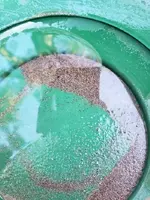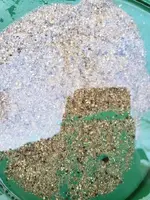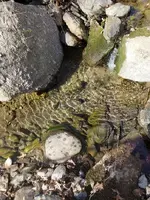I am a newbie gold panner, I'll say that right off the bat. I been practicing with paydirt at home and every time I have been able to find the gold, even the tiniest pieces just big enough to pick up with the most precise tweezers so I know how to shake the pan and how the gold behaves in a pan.
So today I took to the forest and found a nice rocky stream to try for the first time in the wild. Since I'm in Connecticut and know I'm only going to come across very tiny pieces that I gotta work through a lot of pans for I just had a large seasoned pan and a large kitchen strainer to get right to the fine stuff as I knew I wasn't gonna get anything bigger (did find plenty of neat rocks though, very quartz rich area).
So here is where I'm perplexed, for reference I live in a higher elevation and there is in the forest near me a lot of streams with dense crushed rock gravel in them which should give me the best chances at finding anything if I'm not wrong around the bends with a lot of rocks and from the deepest areas of the streams. Wherever I go around the area what I get composition wise is about the same. But no matter where I pan after I classify it with the strainer and get all the dusty crap floated off I am left with this. Whatever these heavy brown sands are they seem to be about as heavy as the black sands and when penning it back with a little material in the pan to check for any flour gold it will roll equally with it, the black sand appears to have slightly more resistance. It's borderline impossible to separate from it. Am I doing something wrong here or is there a material in some areas that behaves just like black sand but isn't? The volume of it is very high too locked with the black sands so I always make sure to constantly be stratifying it as I go.
As you'd probably expect in this state and being a newbie I didn't find anything today but I did get some good experience and can do it better and easier now though I'm having some "heavy" problems here. With how much stratifying and rolling back I'm doing I would think I'd have if there was any flour worth the tweezers gold down there but when getting it down to little enough to work with in the center to see if I have any I feel like I'm losing too much material but the browns just stick with the blacks. With this really crushed up rock stuff do I need to just work with much smaller loads at once? Can anyone help me out here?
edit - So thankfully I actually found some youtube videos of someone panning in CT here, it seems the gravels here are just like this. Seeing wild gold here in the video I definitely haven't seen at all today as it's an unmistakable shiny yellow that really pops. Still would be happy to know exactly what I'm seeing here. Tomorrow I got a day off so I'll be trying again and see if I can find a little something.
So today I took to the forest and found a nice rocky stream to try for the first time in the wild. Since I'm in Connecticut and know I'm only going to come across very tiny pieces that I gotta work through a lot of pans for I just had a large seasoned pan and a large kitchen strainer to get right to the fine stuff as I knew I wasn't gonna get anything bigger (did find plenty of neat rocks though, very quartz rich area).
So here is where I'm perplexed, for reference I live in a higher elevation and there is in the forest near me a lot of streams with dense crushed rock gravel in them which should give me the best chances at finding anything if I'm not wrong around the bends with a lot of rocks and from the deepest areas of the streams. Wherever I go around the area what I get composition wise is about the same. But no matter where I pan after I classify it with the strainer and get all the dusty crap floated off I am left with this. Whatever these heavy brown sands are they seem to be about as heavy as the black sands and when penning it back with a little material in the pan to check for any flour gold it will roll equally with it, the black sand appears to have slightly more resistance. It's borderline impossible to separate from it. Am I doing something wrong here or is there a material in some areas that behaves just like black sand but isn't? The volume of it is very high too locked with the black sands so I always make sure to constantly be stratifying it as I go.
As you'd probably expect in this state and being a newbie I didn't find anything today but I did get some good experience and can do it better and easier now though I'm having some "heavy" problems here. With how much stratifying and rolling back I'm doing I would think I'd have if there was any flour worth the tweezers gold down there but when getting it down to little enough to work with in the center to see if I have any I feel like I'm losing too much material but the browns just stick with the blacks. With this really crushed up rock stuff do I need to just work with much smaller loads at once? Can anyone help me out here?
edit - So thankfully I actually found some youtube videos of someone panning in CT here, it seems the gravels here are just like this. Seeing wild gold here in the video I definitely haven't seen at all today as it's an unmistakable shiny yellow that really pops. Still would be happy to know exactly what I'm seeing here. Tomorrow I got a day off so I'll be trying again and see if I can find a little something.
Amazon Forum Fav 👍
Attachments
Last edited:
Upvote
0






